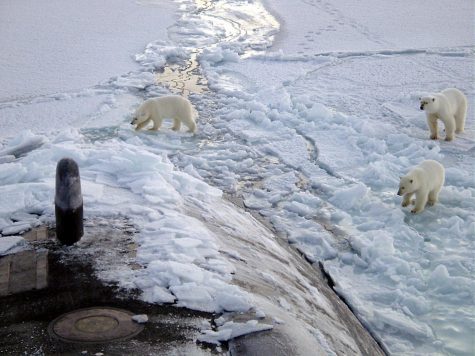Global Warming Causes Dramatic Decrease In Polar Bears
November 1, 2018
Currently, there are between 22,000 and 31,000 polar bears left in the world that are living in their natural habitat. Global warming plays a major role in there population decrease.
Over the past several years global warming has dangerously increased. This caused the ice of the polar bears’ homes to melt. They use the ice to retrieve their food and if they don’t have the ice to access their food then they will grow hungry and die off.

They also rely on the ice to rest and breed. Without it, not only will they starve,but they won’t have an area to reproduce to make up for those who passed.
They also need the ice to camouflage into their environment. A polar bear’s skin is black and their fur is hollow, however, the light reflects off of the ice and snow to make their fur appear white. This is how they adapted to their environment because it allows them to stay hidden when hunting for food or hiding from predators when necessary.

Studies have shown that between 2001 and 2010 there was a 40 percent decrease rate of polar bears in northeast Alaska. That is an extreme amount considering that 40 percent averages to over 1,000 polar bears.
Polar bears are important to the ecosystem and if we don’t do anything to slow down global warming then their absence will have a large negative affect on the world.
For example, since polar bears are near the top of the food web they are great signals when it comes to identifying if something is wrong with the marine life or the water they live in. Also, if polar bears go extinct then all that they prey on such as, seals, beluga whale carcasses, walruses, etc. will all be overpopulated. If this happens then those animals will also die out because their won’t be enough food to feed all of them. This issue is magnified considering that there isn’t much vegetation in the arctic to begin with. The extinction of polar bears will also limit the scavengers who prey off of the leftover meat on the animals that the polar bears kill.
Global warming has also caused rising sea levels resulting from the melted ice. This is a disadvantage to all the arctic animals because it limits them to their space. It also has a negative impact on them because they now have to work harder to retrieve their food.
Pollution is one of the many reasons for global warming. The gasses that are released into the air trap in heat, causing an increase in global temperature. We can help prevent this by walking or biking more often to decrease the amount of fumes being released by cars. Carpooling is also a good way of transportation because there is only one car being used compared to multiple.
Deforestation is also another cause of global warming. The plants absorb carbon dioxide and release oxygen into the atmosphere so the more we have the better it is for the environment. However, because so many people are clearing out trees for farming and construction we aren’t getting enough oxygen to help regulate the climate. Cutting down trees also takes away many species’ habitats forcing them to relocate.
If we better our community and help prevent further increase global warming then we can improve the situation of this dying species, save many lives, and put an end to chaos in the food web.


